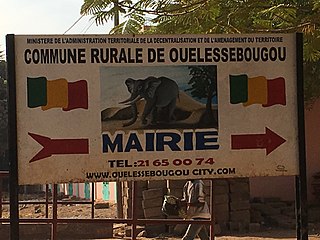Related Research Articles

Mali is a multilingual country of about 21.9 million people. The languages spoken there reflect ancient settlement patterns, migrations, and its long history. Ethnologue counts more than 80 languages. Of these, Bambara, Bobo, Bozo, Dogon, Fula, Hassaniya, Kassonke, Maninke, Minyanka, Senufo, Songhay languages, Soninke and Tamasheq are official languages. French is the working language.
The Gula Iro language is a Bua language spoken by some 3,500 people north and east of Lake Iro in southern Chad, between the Bola and Salamat rivers. It has four dialects, according to Pairault:

Banda district is a district of Uttar Pradesh state of India, and Banda is the district headquarters. It is a part of Chitrakoot Division.
Mono is a language spoken by about 65,000 people in the northwestern corner of the Democratic Republic of the Congo. It is one of the Banda languages, a subbranch of the Ubangian branch of the Niger–Congo languages. It has five dialects: Bili, Bubanda, Mpaka, Galaba, and Kaga.

The Chewa are a Bantu ethnic group found in Malawi, Zambia and few in Mozambique. The Chewa are closely related to people in surrounding regions such as the Tumbuka and Nsenga. They are historically also related to the Bemba, with whom they share a similar origin in the Democratic Republic of the Congo. As with the Nsenga and Tumbuka, a small part of Chewa territory came under the influence of the Ngoni, who were of Zulu or Natal/Transvaal origin. An alternative name, often used interchangeably with Chewa, is Nyanja. Their language is called Chichewa. Internationally, the Chewa are mainly known for their masks and their secret societies, called Nyau, as well as their agricultural techniques.
Banda is a family of Ubangian languages spoken by the Banda people of Central Africa. Banda languages are distributed in the Central African Republic, Democratic Republic of the Congo, and South Sudan.

Cameroon is home to at least 250 languages, with some accounts reporting around 600. These include 55 Afro-Asiatic languages, two Nilo-Saharan languages, four Ubangian languages, and 169 Niger–Congo languages. This latter group comprises one Senegambian language (Fulfulde), 28 Adamawa languages, and 142 Benue–Congo languages . French and English are official languages, a heritage of Cameroon's colonial past as a colony of both France and the United Kingdom from 1916 to 1961. Eight out of the ten regions of Cameroon are primarily francophone and two are anglophone. The official percentage of French and English speakers by the Presidency of Cameroon is estimated to be 70% and 30% respectively.

There are two dozen languages of Bhutan, all members of the Tibeto-Burman language family except for Nepali, which is an Indo-Aryan language, and the Bhutanese Sign Language. Dzongkha, the national language, is the only native language of Bhutan with a literary tradition, though Lepcha and Nepali are literary languages in other countries. Other non-Bhutanese minority languages are also spoken along Bhutan's borders and among the primarily Nepali-speaking Lhotshampa community in South and East Bhutan. Chöke is the language of the traditional literature and learning of the Buddhist monastics.
Psikye is an Afro-Asiatic language spoken in northern Cameroon and eastern Nigeria. Varieties include Psikyɛ and Zləngə. Blench (2006) classifies it as a dialect of Kamwe.
The Ubangian languages form a diverse linkage of some seventy languages centered on the Central African Republic and the DR Congo. They are the predominant languages of the CAR, spoken by 2–3 million people, including one of its official languages, Sango. They are also spoken in Cameroon, Chad, the Republic of Congo and South Sudan.
The Noni language, also called Noone, is an Eastern Beboid language of the Niger–Congo family in Cameroon. The Noone, Ncane, and Mungong varieties are sometimes considered three distinct Noni languages. Ethnologue reports that Ncare is 88% lexically similar with Noone, and 84% with Saari (Nsari).

Ouargli, or Teggargrent, is a Zenati Berber language. It is spoken in the oases of Ouargla (Wargrən) and N'Goussa (Ingusa) in Algeria.
Mbandja is the largest of the Banda languages. There are 350,000 speakers in DRC, 10,000 in the Republic of Congo, and an unknown number in CAR.
Northwest Gbaya is a Gbaya language spoken across a broad expanse of Cameroon and the Central African Republic. The principal variety is Kara, a name shared with several neighboring languages; Lay (Làì) is restricted to a small area north of Mbodomo, with a third between it and Toongo that is not named in Moñino (2010), but is influenced by the Gbaya languages to the south.
Gbanu is a Gbaya language of the Central African Republic. The people do not consider themselves to be ethnically Gbaya.
Central Banda is a dialect continuum of the Banda languages spoken by around one million people, primarily in the Central African Republic. The varieties may be mutually intelligible, especially the Mid-Southern–Gobu–Kpagua–Mono–Ngundu cluster. The other varieties are Bambari, Banda-Banda, Mbrès, Ndélé, and Togbo-Vara Banda.
South Banda is a dialect continuum of the Banda languages spoken by around 200,000 or so people, primarily in the Central African Republic but with ten thousand or so in the Democratic Republic of the Congo. The two varieties may be mutually intelligible.
Kele is a Bantu language of Gabon. Dialects of the Kele language are scattered throughout Gabon.
Geme is a Zande language spoken in two small villages of the Central African Republic.
La'bi is the esoteric ritual language of male initiation among the Gbaya Kara, the Mbum, and some Sara Laka, in the area of Touboro near where the CAR, Chad, and Cameroon meet. It has no native speakers. It is related to Mbum, with substantial loans from one or more Sara languages.
References
- ↑ West Banda at Ethnologue (18th ed., 2015) (subscription required)
- ↑ Moñino, Yves (1988). Lexique comparatif des langues oubanguiennes. Paris: Geuthner.
- ↑ Nougayrol, Pierre. 1989. Les Groupes Banda du Bamingui-Bangoran (RCA). Révue d'Ethnolinguistique (Cahiers du LACITO) 4: 197-208.
- ↑ Sampson, Douglas (1985). Studies in African Linguistics Supplement. pp. 269–274.